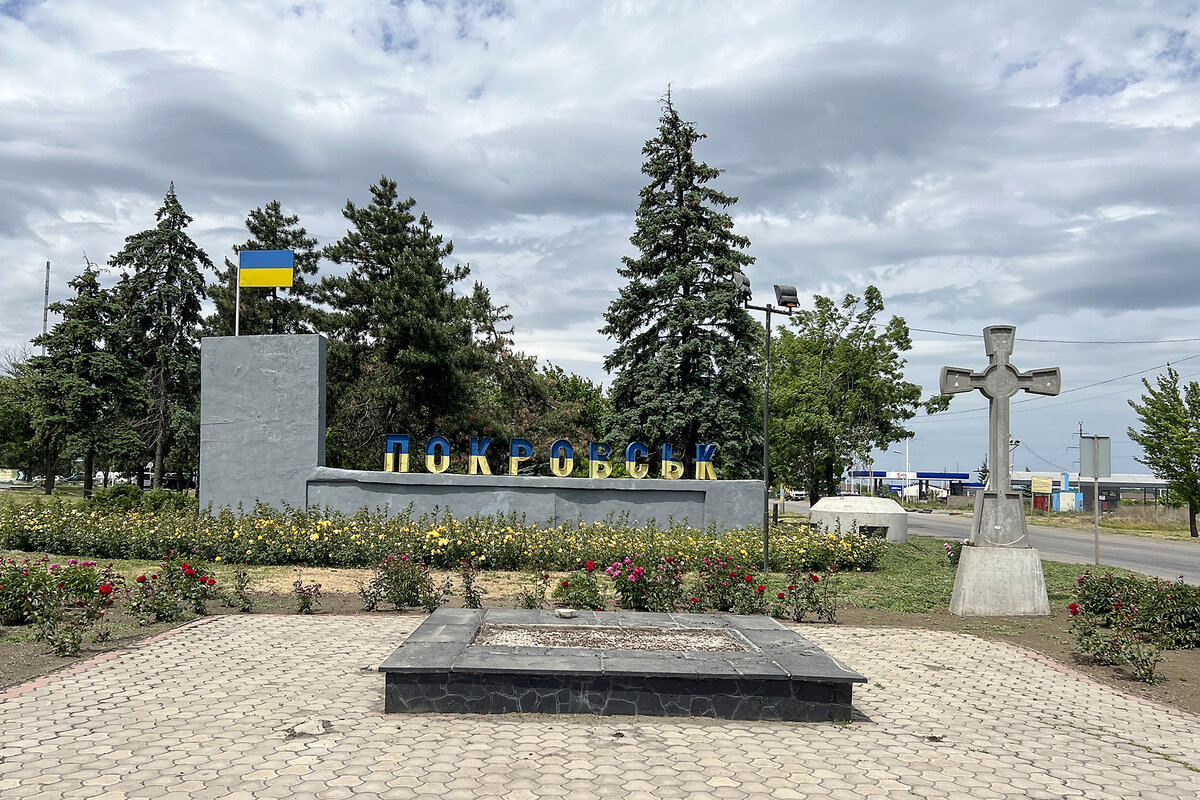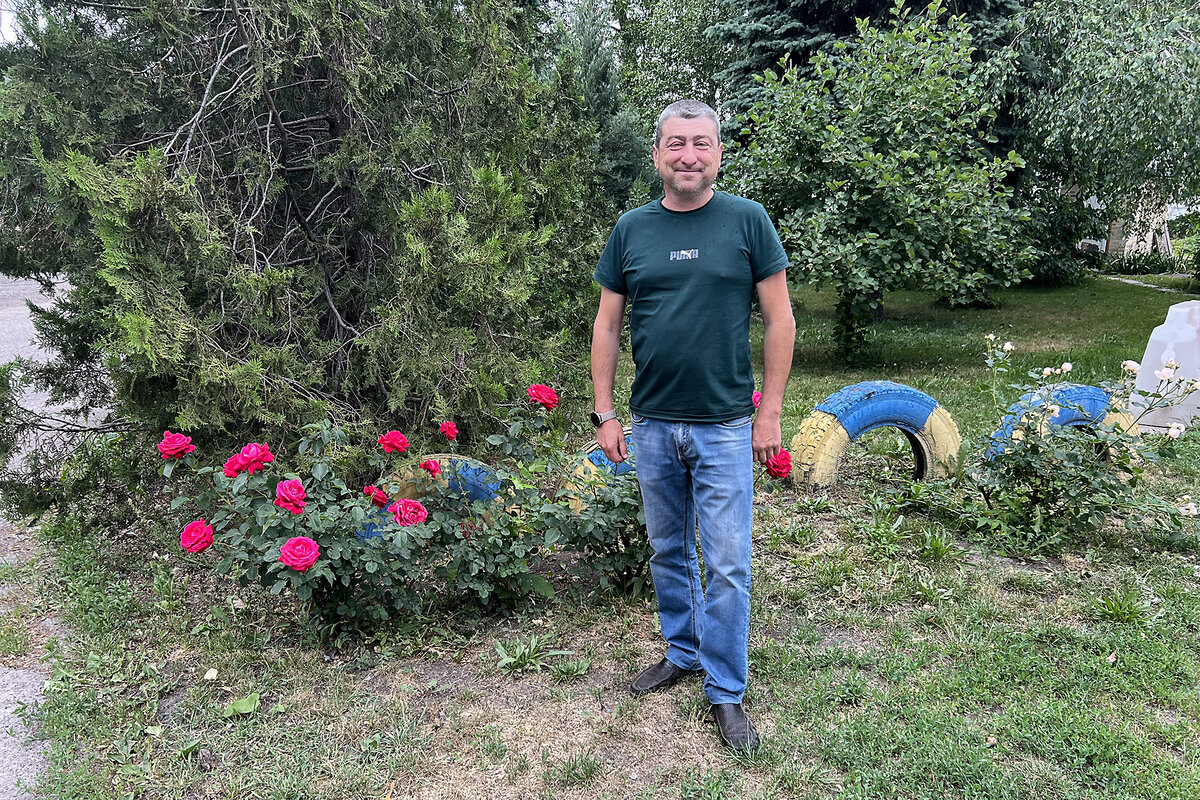In Pokrovsk, Ukraine, a rose is a rose – and a sign of resilience and hope
Loading...
| POKROVSK, Ukraine
Ukraine’s entire Donetsk region has been synonymous with roses since a Soviet-era project made the region’s capital the city of a million roses – a designation recognized by UNESCO in 1970.
The city of Pokrovsk, 40 miles from the now-occupied capital and 20 miles from the war’s front lines, has long had its roses. But the idea of becoming Ukraine’s rose city was launched in 2022 when the mayor announced that despite the war, the city would plant 60,000 new rosebushes.
Why We Wrote This
A story focused onAmid the trials of a long and ugly war, where can people turn for the tranquility and beauty that restores their spirit? Sometimes the solution is right at hand, in parks and private gardens, as the rose lovers of Donetsk, Ukraine, can attest.
“The rose is like us: It has thorns and it protects itself, but it brings beauty into this world,” says Halyna Fateieva, tending her garden at her modest Pokrovsk home. “We too are defending ourselves, but we also give beauty and joy,” she adds. “My neighbors and even strangers say the roses refresh them and give them hope.”
Konstantyn Derevinskyy, director of Pakrovsk’s tranquil Jubilee Park, likewise expresses reverence for the flower and its meaning.
“These are my beauties,” he says, waving to some of the park’s 1,300 rosebushes. “For me they reign over everything else. They are a symbol of the strength of our city. ... They keep blooming no matter what, and that gives people hope.”
In this eastern Ukrainian city’s tranquil and orderly Jubilee Park, numerous precautions and accommodations have been implemented in light of the war that rages 20 miles away.
Fountains have remained dry ever since the pipes providing the park’s main source of water were damaged in Russian shelling this spring. The twinkly lights that once drew families and delighted children in the evenings are left off, so as not to encourage the large crowds that could invite missile strikes.
One attribute, however, not only has not changed, but also has defiantly expanded since Russia occupied parts of the surrounding Donetsk region in February 2022: the glorious rose beds that offer expanses of red, white, and yellow blooms for five months every year.
Why We Wrote This
A story focused onAmid the trials of a long and ugly war, where can people turn for the tranquility and beauty that restores their spirit? Sometimes the solution is right at hand, in parks and private gardens, as the rose lovers of Donetsk, Ukraine, can attest.
“These are my beauties,” says Konstantyn Derevinskyy, Jubilee’s director, as he presents with a sweep of his hand one bed of the 84-acre park’s 1,300 rosebushes. “For me they reign over everything else. They are a symbol of the strength of our city.”
The park has other flowers, like a popular iris allée, he adds, “but the roses are the queen of our flowers. They keep blooming no matter what, and that gives people hope.”
Mr. Derevinskyy is not alone here in his reverence for roses. Indeed, Ukraine’s entire Donetsk region has been synonymous with roses since a Soviet-era project made the region’s capital, some 40 miles from here, the city of a million roses – a designation recognized by UNESCO in 1970.
Now the capital city of Donetsk is occupied by Russia, and the region is on the front lines of war as Russian President Vladimir Putin pursues his goal of annexing all of Donetsk.
Indeed on Friday, Mr. Putin unveiled his latest proposal for ending the war, which calls for Ukraine to cede all of Donetsk to Russia, including Pokrovsk.
But in modest private gardens, town parks, even at gas stations and in highway median strips, the roses of Donetsk have come to symbolize hope and perseverance.
“The rose is like us: It has thorns and it protects itself, but it brings beauty into this world,” says Halyna Fateieva, as she tends a rose garden fit for a queen at her modest Pokrovsk home. “We too are defending ourselves, but we also give beauty and joy,” she adds. “My neighbors and even strangers say the roses refresh them and give them hope.”
Pokrovsk has the feel of other villages and towns along the war’s southeastern front: Some windows are boarded up to protect against blasts; others already blown out are now covered with thick plastic sheeting. Soldiers on rest from the front lines gather at gas stations to consume convenience-store hot dogs and energy drinks and call loved ones.
The quiet attests to a population thinned out by the war.
But the roses, well tended and vigorous, announce that people here have not given up.
At Pokrovsk’s western entrance, the bed of yellow roses below the blue-and-yellow national flag serves as an introduction to Ukraine’s rising rose city.
“They always said Donetsk was the city of a million roses,” notes Mrs. Fateieva, “but people here have planted more roses since the war started, so I think we can claim the title.”
The idea of becoming Ukraine’s rose city was launched in 2022 when the mayor of Pokrovsk announced that despite the war, the city would plant 60,000 new rosebushes. Also that year, the city sent 5,000 rosebushes to Bucha, the town outside Kyiv where Russian soldiers committed atrocities against the population before retreating.
That gesture continued a Donetsk tradition of sending flowers, and in particular roses, to other cities as an expression of appreciation.
In 2020, authorities in occupied Donetsk, which Russia now considers the capital of the Donetsk People’s Republic, sent rose seedlings to St. Petersburg, Moscow, and other Russian cities to thank them for supporting them against Ukraine.
In 2022, Pokrovsk sent 20,000 roses to Ukrainian cities and towns welcoming refugee families from Pokrovsk, and to military hospitals tending soldiers wounded in defense of Pokrovsk’s freedom.
“We have aimed to become the city of roses since 2014, when the city of Donetsk was occupied, but if anything we have increased our efforts since 2022,” says Oleh Tkachenko, manager of municipal grounds maintenance.
Noting that his department still has a “roses director” despite the war, Mr. Tkachenko says the city’s roses aren’t superfluous niceties but play a critical role in reassuring residents and in messaging to the world what Pokrovsk is made of.
“When our residents see us tending the roses, it reassures them that we are going nowhere, that we are doing something today so there will be beauty and joy tomorrow,” he says. To visitors and to the world, he adds, “We are saying, ‘We are Ukraine, Pokrovsk is a Ukrainian city, and we will be here tomorrow.’”
After more than two years of intense war, on top of Russia’s occupation of parts of Donetsk since 2014, some residents who are still here need that reassurance.
“The front line is so close and getting closer, but what can we do but take care of our gardens?” says Iryna, manager of a large nursery on Pokrovsk’s outskirts that for years has been the city’s largest supplier of roses.
The nursery grows a wide variety of plants and trees, but Iryna, who asks that only her first name be used, says the roses mean the most to her. “The roses are like us; they can endure all kinds of conditions,” like the drought currently affecting southern Ukraine, she says. “But like us,” she adds, “they do best when cared for and living in peace.”
Noting that in better times the nursery offered more than 120 varieties of roses, Iryna says one variety – Gloria Dei, or “the glory of God” – remains the nursery’s bestseller. She excuses herself for choking up, but then she explains: “I think people seek it as a way of saying, ‘Please, let there be peace.’”
In her garden, Mrs. Fateieva offers a similar thought as she cuts a bouquet of roses for passing strangers.
“I love these roses, but I don’t see them as being all mine,” she says. “They are in my garden, but their message of hope and peace is for everyone.”
Oleksandr Naselenko assisted in reporting this story.











